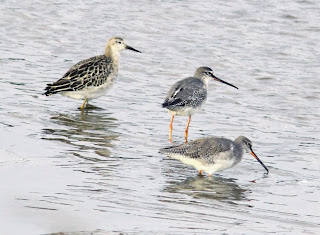The weather of the past week or so brought in a wind-blown juvenile Red-necked Phalarope to Lytham St Annes today, which wasn’t a complete surprise or without precedent, although it’s a good few years that I saw both a Grey Phalarope and a Red-necked Phalarope together on Fairhaven Lake in similar circumstances. Wherever I went today I looked in suitable locations for a phalarope but didn’t find another, especially a Red-necked Phalarope in breeding plumage.

When I got to Lane Ends I was surprised by the overnight arrival of huge numbers of Pink-footed Geese. So ringers weren’t the only ones waiting for the winds to subside, and as the low pressure moved across to Scandinavia it allowed the geese a nice window of opportunity to head south from Iceland. Initially I counted what I thought to be about 700 birds out on the marsh, and then two microlight aircraft came by, one seemingly buzzing the geese and panicking them into the air twice, as the other craft landed heavily out on the sands. The only beneficiary of this was me being able to get a more accurate count of 1200 birds, a large increase on the parties of 8 and 40 I had seen earlier in the week.


The goose frighteners also put to flight 9 Little Egrets that had been feeding in the ditches and out towards the tideline; in addition they alarmed 3 similarly hidden Greenshank that then flew off to find somewhere quieter. The disturbance also caused a couple of parties of Teal to fly back towards the wildfowler’s pools, just 30 in total.

I turned my attention to passerine hunting, but could find low numbers only, less than 10 each of Linnet, Goldfinch and 2 Skylark, with 12 Meadow Pipit, the latter species yet to appear in anything like the numbers it should by mid-September. There were 6 Wheatears about so I tried my luck, weighing up where the birds fed and how they might react to my movements and the traps themselves. I had one success, an adult female, but had my second trap not broke a vital part at a crucial time I would almost certainly have bagged another as when I approached the trap, two other Wheatears were closely watching the already caught bird.
The bird turned out to have a wing length of 96mm, just outside the range of any “Greenland” types and was almost certainly of Icelandic origin, given the time of year and the incidence of geese and phalaropes.


There was nothing much else about so I wound my way to Cockersands and a check on the set aside with a view to ringing some finches soon. Zero, not a bird, such is the life of a ringer, but checking what birds are up to is the name of the game. I did see the local Kestrel, maybe that explains it. On my way back I found a single Ruff on a private field, and on a private pool of its own so left it in peace.







.jpg)












































.jpg)












